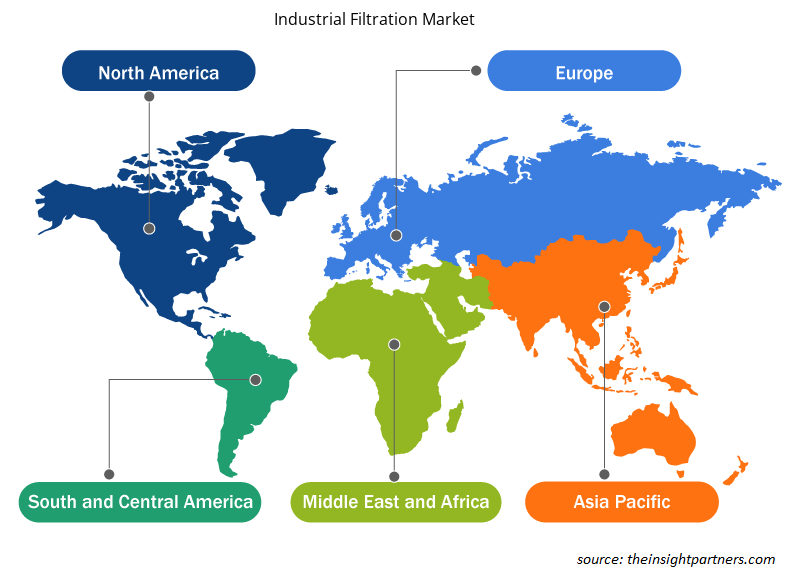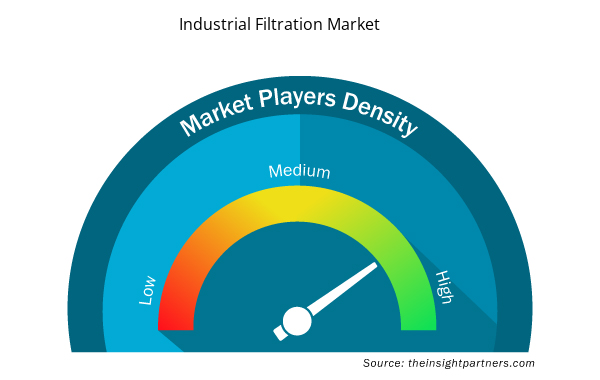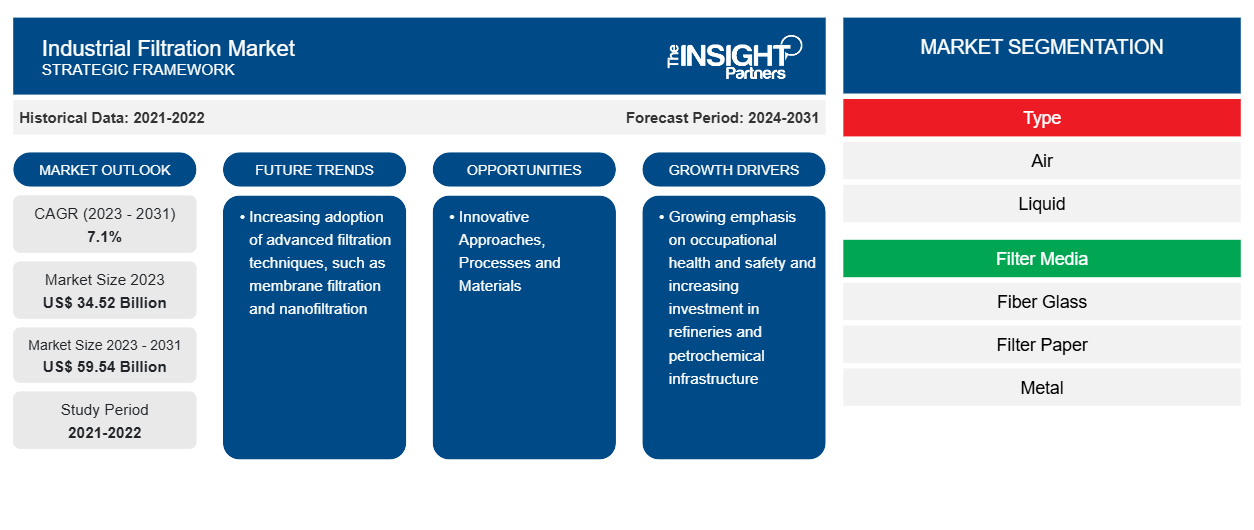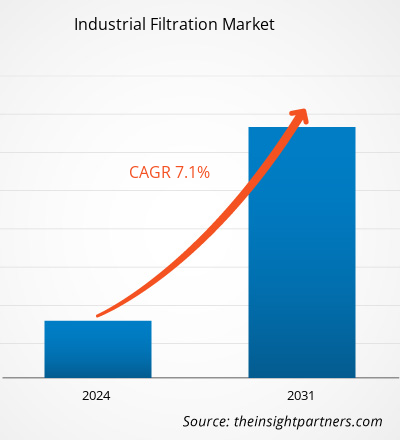Der Markt für industrielle Filtration soll von 34,52 Milliarden US-Dollar im Jahr 2023 auf 59,54 Milliarden US-Dollar im Jahr 2031 anwachsen. Der Markt wird zwischen 2023 und 2031 voraussichtlich eine durchschnittliche jährliche Wachstumsrate von 7,1 % verzeichnen. Die zunehmende Einführung fortschrittlicher Filtrationstechniken wie Membranfiltration und Nanofiltration dürfte ein wichtiger Trend auf dem Markt bleiben.
Marktanalyse für industrielle Filtration
In den letzten Jahren hat der Markt für Industriefiltration ein erhebliches Wachstum erlebt. Faktoren wie die zunehmende Industrialisierung und Urbanisierung, steigende Industriebetriebe, die zunehmende Betonung von Arbeitssicherheit und Gesundheitsschutz sowie ein zunehmendes Bewusstsein und Vorschriften in Bezug auf ökologische Nachhaltigkeit sind einige der Faktoren, die das Wachstum des Marktes für Industriefiltration vorantreiben. Innovative Ansätze, Prozesse und Materialien boten lukrative Wachstumschancen für den Markt für Industriefiltration.
Marktübersicht für industrielle Filtration
Unter Industriefiltration versteht man einen Prozess, mit dem Industrien ihre Produkte von Schutt und Rückständen sowie anderen Abfallprodukten filtern. Bei der Industriefiltration geht es darum, Abfälle zur sicheren Entsorgung zu trocknen und das Endprodukt zu veredeln. Die Filtration ist für verschiedene Branchen wie Bergbau, Erdgas, Flüssigabfallmanagement, Wasser, Lebensmittel- und Getränkeverpackung , Erzeugung erneuerbarer Energie und andere unverzichtbar. Es gibt verschiedene Typen von Industriefiltern, die anhand ihrer mechanischen und physikalischen Eigenschaften klassifiziert werden. Einige dieser Industriefilter sind Schwerkraftfilter, Druck-/Vakuumfilter, Blattfilter, Rotationstrommel-Vakuumfilter und andere.
Passen Sie diesen Bericht Ihren Anforderungen an
Sie erhalten kostenlos individuelle Anpassungen an jedem Bericht, einschließlich Teilen dieses Berichts oder einer Analyse auf Länderebene, eines Excel-Datenpakets sowie tolle Angebote und Rabatte für Start-ups und Universitäten.
- Holen Sie sich die wichtigsten Markttrends aus diesem Bericht.Dieses KOSTENLOSE Beispiel umfasst eine Datenanalyse von Markttrends bis hin zu Schätzungen und Prognosen.
Treiber und Chancen auf dem Markt für industrielle Filtration
Wachsende Betonung von Gesundheit und Sicherheit am Arbeitsplatz begünstigt den Markt
In der heutigen dynamischen Welt ist es wichtig, das Wohlbefinden der Arbeitnehmer sicherzustellen. Ein sicherer Arbeitsplatz ist der Grundstein für eine gesunde Umgebung und fördert zudem eine höhere Produktivität und einen besseren Ruf des Unternehmens. Die Gewährleistung der Sicherheit am Arbeitsplatz umfasst die Umsetzung verschiedener Präventivmaßnahmen, Sicherheitsrichtlinien und -verfahren, um Verletzungen, Unfälle und Krankheiten am Arbeitsplatz zu minimieren. Um die Sicherheit am Arbeitsplatz zu gewährleisten, investieren verschiedene Branchen wie Fertigung, Bergbau, Pharmazeutik und andere zunehmend in fortschrittliche Filtertechnologien, um ihre Belegschaft vor schädlichen Partikeln, Chemikalien und Dämpfen zu schützen.
Innovative Ansätze, Prozesse und Materialien
Maschinenausfälle sind eines der größten Produktionsprobleme für Hersteller. Verunreinigungen wie Staub, Schweißschlacke, Ölnebel, Gummipartikel aus Schläuchen und Dichtungen, Sand aus Gussteilen und Metallspäne aus bearbeiteten Komponenten sind die Hauptursachen für Maschinenausfälle. Sowohl die Reparaturkosten als auch die Ausfallzeiten sind kostspielig. Da sich die Verbraucher zunehmend der negativen Auswirkungen von Verunreinigungen bewusst werden, besteht eine erhöhte Nachfrage nach verbesserten Prozessen und Produkten, die dazu beitragen, Ausfallzeiten zu reduzieren, die Lebensdauer des Schmiermittels zu verlängern und die Kosten zu senken. In einem solchen Szenario setzen Unternehmen zunehmend Fortschritte bei der Filtration in drei Bereichen um: langlebigere Filterdesigns, leistungsstärkere Materialien und automatisierte Filterüberwachung (Internet der Dinge), um diese Probleme zu lösen.
Segmentierungsanalyse des Marktberichts zur industriellen Filtration
Wichtige Segmente, die zur Ableitung der Marktanalyse für industrielle Filterung beigetragen haben, sind Typ, Filtermedium und Branche.
- Der Markt für Industriefiltration ist nach Typ in Luft und Flüssigkeit unterteilt. Das Luftsegment hatte im Jahr 2023 einen größeren Marktanteil.
- Nach Filtermedien ist der Markt in Glasfaser, Filterpapier, Metall und Vliesstoffe segmentiert. Das Segment Vliesstoffe hatte im Jahr 2023 den größten Marktanteil.
- Branchenmäßig ist der Markt in Lebensmittel und Getränke, Metall und Bergbau, Chemie, Pharmazie, Energieerzeugung und andere unterteilt. Das Lebensmittel- und Getränkesegment dürfte im Prognosezeitraum mit der höchsten durchschnittlichen jährlichen Wachstumsrate wachsen.CAGR over the forecast period.
Marktanteilsanalyse für industrielle Filtration nach Geografie
Der geografische Umfang des Marktberichts zur industriellen Filterung ist hauptsächlich in fünf Regionen unterteilt: Nordamerika, Asien-Pazifik, Europa, Naher Osten und Afrika sowie Süd- und Mittelamerika.
Der europäische Markt für Industriefilter dürfte in absehbarer Zukunft ein deutliches Wachstum verzeichnen. Europa hat bei der Umsetzung strenger Umweltvorschriften und -standards zur Reduzierung der Auswirkungen industrieller Emissionen eine Vorreiterrolle eingenommen. Diese Vorschriften betonen die Verwendung ungiftiger Materialien, die Änderung von Herstellungsverfahren und Konservierungstechniken. Infolgedessen setzen europäische Industrien zunehmend industrielle Filtersysteme ein, um diese Vorschriften einzuhalten und die Umweltverschmutzung zu reduzieren, und treiben so den regionalen Markt für Industriefilter voran.
Regionale Einblicke in den Markt für industrielle Filtration
Die regionalen Trends und Faktoren, die den Markt für industrielle Filtration im Prognosezeitraum beeinflussen, wurden von den Analysten von Insight Partners ausführlich erläutert. In diesem Abschnitt werden auch Marktsegmente und Geografien für industrielle Filtration in Nordamerika, Europa, im asiatisch-pazifischen Raum, im Nahen Osten und Afrika sowie in Süd- und Mittelamerika erörtert.

- Erhalten Sie regionale Daten zum Markt für industrielle Filtration
Umfang des Marktberichts zur industriellen Filtration
| Berichtsattribut | Details |
|---|---|
| Marktgröße im Jahr 2023 | 34,52 Milliarden US-Dollar |
| Marktgröße bis 2031 | 59,54 Milliarden US-Dollar |
| Globale CAGR (2023 - 2031) | 7,1 % |
| Historische Daten | 2021-2022 |
| Prognosezeitraum | 2024–2031 |
| Abgedeckte Segmente | Nach Typ
|
| Abgedeckte Regionen und Länder | Nordamerika
|
| Marktführer und wichtige Unternehmensprofile |
|
Dichte der Marktteilnehmer für industrielle Filtration: Deren Auswirkungen auf die Geschäftsdynamik verstehen
Der Markt für Industriefiltration wächst rasant, angetrieben durch die steigende Nachfrage der Endnutzer aufgrund von Faktoren wie sich entwickelnden Verbraucherpräferenzen, technologischen Fortschritten und einem größeren Bewusstsein für die Vorteile des Produkts. Mit steigender Nachfrage erweitern Unternehmen ihr Angebot, entwickeln Innovationen, um die Bedürfnisse der Verbraucher zu erfüllen, und nutzen neue Trends, was das Marktwachstum weiter ankurbelt.
Die Marktteilnehmerdichte bezieht sich auf die Verteilung von Firmen oder Unternehmen, die in einem bestimmten Markt oder einer bestimmten Branche tätig sind. Sie gibt an, wie viele Wettbewerber (Marktteilnehmer) in einem bestimmten Marktraum im Verhältnis zu seiner Größe oder seinem gesamten Marktwert präsent sind.
Die wichtigsten auf dem Markt für industrielle Filtration tätigen Unternehmen sind:
- Industrielle Filtration, Inc.
- Alfa Laval AB
- Eaton Corporation Plc
- 3M Unternehmen
- Clarcor Inc.
- Cummins-Filtration
Haftungsausschluss : Die oben aufgeführten Unternehmen sind nicht in einer bestimmten Reihenfolge aufgeführt.

- Überblick über die wichtigsten Akteure auf dem Markt für industrielle Filtration
Neuigkeiten und aktuelle Entwicklungen zum Markt für industrielle Filtration
Der Markt für industrielle Filterung wird durch die Erhebung qualitativer und quantitativer Daten aus Primär- und Sekundärforschung bewertet, die wichtige Unternehmenspublikationen, Verbandsdaten und Datenbanken umfasst. Nachfolgend sind einige der Entwicklungen auf dem Markt für industrielle Filterung aufgeführt:
- Pall Corporation, ein renommierter Weltmarktführer im Bereich industrieller Filtration, Trenn- und Reinigungstechnologie, wird auf der SEMICON West seine Filtrations- und Reinigungstechnologie der nächsten Generation vorstellen. Dieser strategische Schritt steht im Einklang mit der steigenden Nachfrage nach fortschrittlichen Chips mit verbesserter Leistung und Energieeffizienz, die durch die zunehmende Verbreitung von 5G-, KI- und IoT-Geräten vorangetrieben wird. (Quelle: Pall Corporation, Pressemitteilung, Juli 2023)
- Die MANN+HUMMEL Gruppe, ein weltweit führender Anbieter von Filtrationslösungen, hat kürzlich eine Mehrheitsbeteiligung an Suzhou U-Air Environmental Technology erworben. Dieser strategische Schritt ist auf die steigende weltweite Nachfrage nach saubereren Luftlösungen zurückzuführen und zielt darauf ab, die Präsenz von MANN+HUMMEL auf dem chinesischen und südostasiatischen Luftfiltrationsmarkt zu stärken. Die Übernahme von Suzhou U-Air Environmental Technology ermöglicht es MANN+HUMMEL, sein Produktportfolio zu erweitern und der steigenden Nachfrage der Region nach Luftfiltrationslösungen gerecht zu werden. (Quelle: MANN+HUMMEL Gruppe, Pressemitteilung, Oktober 2023)
Marktbericht zur industriellen Filtration – Umfang und Ergebnisse
Der Bericht „Marktgröße und Prognose für industrielle Filtration (2021–2031)“ bietet eine detaillierte Analyse des Marktes, die die folgenden Bereiche abdeckt:
- Größe und Prognose des Industriefiltrationsmarktes auf globaler, regionaler und Länderebene für alle wichtigen Marktsegmente, die im Rahmen des Projekts abgedeckt sind
- Markttrends für industrielle Filtration sowie Marktdynamik wie Treiber, Einschränkungen und wichtige Chancen
- Detaillierte PEST/Porters Five Forces- und SWOT-Analyse
- Marktanalyse für Industriefiltration mit wichtigen Markttrends, globalen und regionalen Rahmenbedingungen, wichtigen Akteuren, Vorschriften und aktuellen Marktentwicklungen
- Branchenlandschaft und Wettbewerbsanalyse, die die Marktkonzentration, Heatmap-Analyse, prominente Akteure und aktuelle Entwicklungen auf dem Markt für industrielle Filtration umfasst
- Detaillierte Firmenprofile
- Historische Analyse (2 Jahre), Basisjahr, Prognose (7 Jahre) mit CAGR
- PEST- und SWOT-Analyse
- Marktgröße Wert/Volumen – Global, Regional, Land
- Branche und Wettbewerbsumfeld
- Excel-Datensatz



Report Coverage
Revenue forecast, Company Analysis, Industry landscape, Growth factors, and Trends

Segment Covered
This text is related
to segments covered.

Regional Scope
North America, Europe, Asia Pacific, Middle East & Africa, South & Central America

Country Scope
This text is related
to country scope.
Häufig gestellte Fragen
North America is expected to dominate the market in 2023
The global industrial filtration market is projected to reach US$ 59.54 billion by 2031.
The leading players operating in the industrial filtration market are Industrial Filtration, Inc., Alfa Laval AB, Eaton Corporation Plc, 3M Company, Clarcor Inc., Cummins Filtration, Pentair Plc, Donaldson Company, Inc., Lenntech, Parker Hannifin Corporation, Pall Corporation, MANN+HUMMEL, Fleetlife Inc, Metso, Camfil, HYDAC, Hengst Filtration Pvt. Ltd.
The increasing adoption of advanced filtration techniques, such as membrane filtration and nanofiltration, is anticipated to play a significant role in the global industrial filtration market in the coming years.
The major factors driving the industrial filtration market are the growing emphasis on occupational health and safety and increasing investment in refineries and petrochemical infrastructure.
The global industrial filtration market is expected to grow at a CAGR of 7.1% during 2023 - 2031.
Trends and growth analysis reports related to Electronics and Semiconductor : READ MORE..
The List of Companies
1. Industrial Filtration, Inc.
2. Alfa Laval AB
3. Eaton Corporation Plc
4. 3M Company
5. Clarcor Inc.
6. Cummins Filtration
7. Pentair Plc
8. Donaldson Company, Inc.
9. Lenntech
10. Parker Hannifin Corporation
The Insight Partners performs research in 4 major stages: Data Collection & Secondary Research, Primary Research, Data Analysis and Data Triangulation & Final Review.
- Data Collection and Secondary Research:
As a market research and consulting firm operating from a decade, we have published and advised several client across the globe. First step for any study will start with an assessment of currently available data and insights from existing reports. Further, historical and current market information is collected from Investor Presentations, Annual Reports, SEC Filings, etc., and other information related to company’s performance and market positioning are gathered from Paid Databases (Factiva, Hoovers, and Reuters) and various other publications available in public domain.
Several associations trade associates, technical forums, institutes, societies and organization are accessed to gain technical as well as market related insights through their publications such as research papers, blogs and press releases related to the studies are referred to get cues about the market. Further, white papers, journals, magazines, and other news articles published in last 3 years are scrutinized and analyzed to understand the current market trends.
- Primary Research:
The primarily interview analysis comprise of data obtained from industry participants interview and answers to survey questions gathered by in-house primary team.
For primary research, interviews are conducted with industry experts/CEOs/Marketing Managers/VPs/Subject Matter Experts from both demand and supply side to get a 360-degree view of the market. The primary team conducts several interviews based on the complexity of the markets to understand the various market trends and dynamics which makes research more credible and precise.
A typical research interview fulfils the following functions:
- Provides first-hand information on the market size, market trends, growth trends, competitive landscape, and outlook
- Validates and strengthens in-house secondary research findings
- Develops the analysis team’s expertise and market understanding
Primary research involves email interactions and telephone interviews for each market, category, segment, and sub-segment across geographies. The participants who typically take part in such a process include, but are not limited to:
- Industry participants: VPs, business development managers, market intelligence managers and national sales managers
- Outside experts: Valuation experts, research analysts and key opinion leaders specializing in the electronics and semiconductor industry.
Below is the breakup of our primary respondents by company, designation, and region:

Once we receive the confirmation from primary research sources or primary respondents, we finalize the base year market estimation and forecast the data as per the macroeconomic and microeconomic factors assessed during data collection.
- Data Analysis:
Once data is validated through both secondary as well as primary respondents, we finalize the market estimations by hypothesis formulation and factor analysis at regional and country level.
- Macro-Economic Factor Analysis:
We analyse macroeconomic indicators such the gross domestic product (GDP), increase in the demand for goods and services across industries, technological advancement, regional economic growth, governmental policies, the influence of COVID-19, PEST analysis, and other aspects. This analysis aids in setting benchmarks for various nations/regions and approximating market splits. Additionally, the general trend of the aforementioned components aid in determining the market's development possibilities.
- Country Level Data:
Various factors that are especially aligned to the country are taken into account to determine the market size for a certain area and country, including the presence of vendors, such as headquarters and offices, the country's GDP, demand patterns, and industry growth. To comprehend the market dynamics for the nation, a number of growth variables, inhibitors, application areas, and current market trends are researched. The aforementioned elements aid in determining the country's overall market's growth potential.
- Company Profile:
The “Table of Contents” is formulated by listing and analyzing more than 25 - 30 companies operating in the market ecosystem across geographies. However, we profile only 10 companies as a standard practice in our syndicate reports. These 10 companies comprise leading, emerging, and regional players. Nonetheless, our analysis is not restricted to the 10 listed companies, we also analyze other companies present in the market to develop a holistic view and understand the prevailing trends. The “Company Profiles” section in the report covers key facts, business description, products & services, financial information, SWOT analysis, and key developments. The financial information presented is extracted from the annual reports and official documents of the publicly listed companies. Upon collecting the information for the sections of respective companies, we verify them via various primary sources and then compile the data in respective company profiles. The company level information helps us in deriving the base number as well as in forecasting the market size.
- Developing Base Number:
Aggregation of sales statistics (2020-2022) and macro-economic factor, and other secondary and primary research insights are utilized to arrive at base number and related market shares for 2022. The data gaps are identified in this step and relevant market data is analyzed, collected from paid primary interviews or databases. On finalizing the base year market size, forecasts are developed on the basis of macro-economic, industry and market growth factors and company level analysis.
- Data Triangulation and Final Review:
The market findings and base year market size calculations are validated from supply as well as demand side. Demand side validations are based on macro-economic factor analysis and benchmarks for respective regions and countries. In case of supply side validations, revenues of major companies are estimated (in case not available) based on industry benchmark, approximate number of employees, product portfolio, and primary interviews revenues are gathered. Further revenue from target product/service segment is assessed to avoid overshooting of market statistics. In case of heavy deviations between supply and demand side values, all thes steps are repeated to achieve synchronization.
We follow an iterative model, wherein we share our research findings with Subject Matter Experts (SME’s) and Key Opinion Leaders (KOLs) until consensus view of the market is not formulated – this model negates any drastic deviation in the opinions of experts. Only validated and universally acceptable research findings are quoted in our reports.
We have important check points that we use to validate our research findings – which we call – data triangulation, where we validate the information, we generate from secondary sources with primary interviews and then we re-validate with our internal data bases and Subject matter experts. This comprehensive model enables us to deliver high quality, reliable data in shortest possible time.


 Holen Sie sich ein kostenloses Muster für diesen Bericht
Holen Sie sich ein kostenloses Muster für diesen Bericht